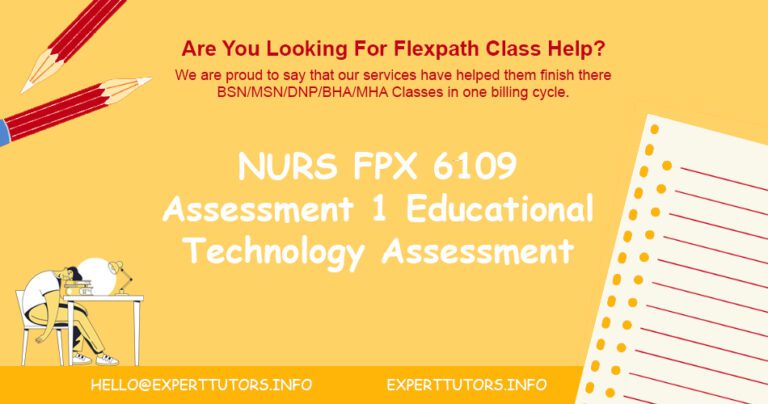NURS FPX 6109 Assessment 1: Educational Technology Assessment Needs
Name
Capella University
FPX-6109
Instructor’s Name
April 2024
Educational Technology Assessment Needs
The effectiveness of educational technology in nursing education is pivotal for improving patient outcomes and enhancing nursing staff performance. As the director of nursing education at Haven Healthcare Center, it is imperative to assess the current state of educational technology use and identify areas for improvement. In addition to comparing the current state with the desired state, the assessment tries to analyze how nurses currently utilize educational technology within the organization.
How Nurses Currently Use the Technology
Currently, nurses at Haven Healthcare Center utilize educational technology across various aspects of their professional development. E-learning platforms are commonly employed for accessing online courses and resources, allowing nurses to engage in self-paced learning and stay updated with the latest evidence-based practices. Simulation equipment is utilized to facilitate hands-on training in realistic clinical scenarios, providing nurses with valuable opportunities to practice skills and decision-making in a safe environment. Additionally, remote communication technologies are utilized for virtual meetings, conferences, and consultations, enabling collaboration among nursing staff and access to expert knowledge. However, uncertainties remain regarding the extent of technology usage among different nursing departments, specific feedback from nurses regarding the effectiveness of current technologies, and any barriers hindering optimal utilization of educational technology in certain contexts.
The Comparison with the Desired Technology State
The current state of educational technology use at Haven Healthcare Center reveals a foundation for professional development and training among nursing staff. E-learning platforms, simulation equipment, and remote communication technologies are in place, offering avenues for self-directed learning, hands-on practice, and collaboration. However, there exists a gap between the current state and the desired state of educational technology implementation. While these tools are available, their integration into nursing education may lack cohesion and optimization. Best practices suggest a seamless integration of educational technology into nursing education, providing personalized learning experiences, immersive simulations, and robust collaboration platforms (Gause et al., 2022). Therefore, the desired state entails a more holistic approach to educational technology, where resources are strategically aligned with educational objectives, user feedback drives iterative improvements, and innovative technologies are leveraged to enhance learning outcomes.
The SWOT Analysis
| StrengthsComprehensive integration of educational technology into nursing education programs.User-friendly e-learning platforms with personalized learning pathways and interactive learning tools.Robust collaborative learning communities that foster knowledge sharing and professional development among nursing staff. | Opportunities Potential for continuous improvement through feedback mechanisms and data-driven decision-making.Opportunity to leverage emerging technologies to further enhance nursing education and patient care outcomes.Room for growth in strategic partnerships with educational technology vendors and industry experts. |
| Weaknesses Need for ongoing evaluation and refinement of educational technology strategies to ensure alignment with organizational goals.Continued efforts required to address potential resistance to change and ensure buy-in from nursing staff.Resource constraints may limit the organization’s ability to implement desired changes in a timely manner. | ThreatsRisk of technology disruptions or cybersecurity threats that may impact the effectiveness of educational technology initiatives.Potential for budget cuts or funding limitations that could impede progress towards the desired state.External factors such as regulatory changes or shifts in healthcare policies may require adaptation of educational technology strategies. |
Metrics Used and their Assessment
The staff engagement and participation rates in educational programs, performance improvement metrics like competency assessments and skill acquisition, and patient outcomes connected to nursing care and interventions are some of the metrics used at Haven Healthcare Center to assess the benefits of the current use of educational technology. There is need for improvement in the quality, interpretation, and application of these indicators, even while they offer insightful information about how well educational technology is working (Ryan et al., 2021).
Firstly, the current metrics lack standardization, making it challenging to compare results across different educational programs or initiatives. To address this, Haven Healthcare Center can establish clear benchmarks and outcome measures for educational technology use, ensuring consistency in data collection and analysis. Additionally, there is a need to refine data collection methods to capture more comprehensive information on the impact of educational technology on nursing practice and patient outcomes. This involves implementing regular evaluations of educational programs and utilizing technology-enabled data analytics tools to track performance metrics over time (Brown et al., 2020).
Furthermore, interpreting the data collected from these metrics requires careful consideration of contextual factors and potential confounding variables. For instance, while increased staff engagement in educational programs may indicate the effectiveness of educational technology, other factors such as workload and organizational culture may also influence participation rates. Therefore, it is essential to contextualize the data within the broader organizational context and consider the perspectives of nursing staff and other stakeholders when interpreting the results.
To enhance the use of data derived from these metrics, Haven Healthcare Center can implement a systematic approach to data analysis and reporting, ensuring that findings are communicated effectively to relevant stakeholders. This involve developing dashboards or reports that provide real-time insights into the impact of educational technology on nursing education and patient outcomes (Epstein et al., 2020).
Organizational Mission Aligned with the Technology
At Haven Healthcare Center, the strategic mission revolves around providing high-quality patient care through continuous improvement, innovation, and professional development. Educational technology, both new and existing, plays a pivotal role in advancing this mission by facilitating ongoing learning and skill development among nursing staff, ultimately leading to improved patient outcomes.
Firstly, educational technology enhances professional development opportunities for nursing staff by providing access to a diverse range of educational resources and learning experiences. E-learning platforms offer flexibility and convenience, allowing nurses to engage in self-paced learning modules, attend virtual lectures, and access up-to-date clinical guidelines and research articles (Tashkandi, 2021). This aligns with the organization’s mission of continuous improvement by empowering nurses to stay abreast of advancements in healthcare practices and technologies.
Secondly, simulation equipment enables nurses to engage in hands-on training in realistic clinical scenarios, bridging the gap between theory and practice. By simulating challenging clinical situations in a safe environment, nurses can enhance their clinical skills, critical thinking abilities, and decision-making processes (Johnsen et al., 2021). This fosters a culture of innovation within the organization by encouraging experimentation and exploration of new approaches to patient care.
Moreover, remote communication technologies facilitate collaboration and knowledge sharing among nursing staff, regardless of geographical location. Virtual meetings, conferences, and consultations enable interdisciplinary collaboration, allowing nurses to consult with specialists, share best practices, and participate in ongoing professional development activities (Pandey et al., 2021). This collaborative approach to learning enhances teamwork and communication skills among nursing staff, ultimately leading to improved patient care and outcomes.
Recommendations for Technology Use
Based on a comprehensive needs assessment at Haven Healthcare Center, several actionable recommendations can be made to improve nursing education through changes to existing educational technology or its current use:
- Enhanced Accessibility and Usability: Streamline access to educational resources by improving the user interface and navigation of existing e-learning platforms. Implement user-friendly features such as search functionalities, personalized learning paths, and mobile compatibility to accommodate the diverse learning needs of nursing staff. By enhancing accessibility and usability, nurses can more easily locate relevant educational materials and engage in self-directed learning activities, ultimately improving their knowledge retention and skill acquisition (Nes et al., 2021).
- Integration of Interactive Learning Tools: Incorporate interactive learning tools such as virtual patient simulations and gamified assessments into existing educational technology platforms. These tools provide immersive learning experiences that allow nurses to apply theoretical knowledge to real-world scenarios in a risk-free environment (Nes et al., 2021). By engaging in hands-on practice and receiving immediate feedback, nurses can enhance their clinical decision-making skills and confidence in patient care, leading to improved clinical outcomes.
- Personalized Learning Pathways: Implement personalized learning pathways within e-learning platforms, allowing nurses to tailor their educational experiences based on their individual learning preferences, competency levels, and professional goals. Utilize adaptive learning algorithms to dynamically adjust the difficulty and pace of learning modules based on each nurse’s performance and progress (Nes et al., 2021). By offering personalized learning pathways, nurses can maximize their learning potential and achieve mastery in areas of clinical practice that align with their career aspirations and organizational needs.
- Collaborative Learning Communities: Foster collaborative learning communities within the organization by integrating social learning features into existing educational technology platforms. Create discussion forums, virtual study groups, and peer mentoring programs where nurses can share insights, exchange best practices, and support each other’s professional development journey. By facilitating knowledge sharing and collaboration among nursing staff, the organization can cultivate a culture of continuous learning and innovation, leading to improved patient care and staff satisfaction.
- Continuous Evaluation and Improvement: Establish a systematic process for evaluating the effectiveness of educational technology initiatives through ongoing data collection and analysis. Monitor key performance metrics such as staff engagement, knowledge retention, and clinical competency to assess the impact of changes made to existing technology or its use. Solicit feedback from nursing staff through surveys, focus groups, and performance reviews to identify areas for further improvement and refinement. By continuously evaluating and refining educational technology strategies, the organization can ensure that nursing education remains responsive to evolving clinical practices and patient care needs.
NURS FPX 6109 Assessment 1 : Educational Technology Assessment Needs Conclusion
The assessment highlights the importance of strategically leveraging educational technology to enhance nursing education and improve patient outcomes at Haven Healthcare Center. By identifying current strengths, weaknesses, opportunities, and threats in educational technology use, actionable recommendations have been proposed to bridge the gap between the current state and the desired state. Through ongoing evaluation, refinement, and alignment with organizational goals, Haven Healthcare Center can maximize the effectiveness of educational technology initiatives, fostering a culture of continuous learning, innovation, and excellence in patient care.
NURS FPX 6109 Assessment 1 : References
Brown, J., Pope, N., Maria, A., Mason, J., & Morgan, A. (2020). Issues affecting nurses’ capability to use digital technology at work: An integrative review. Journal of Clinical Nursing, 29(15-16), 2801–2819. https://doi.org/10.1111/jocn.15321
Epstein, J. A., Noronha, C., & Berkenblit, G. (2020). Smarter screen time: Integrating clinical dashboards into graduate medical education. Journal of Graduate Medical Education, 12(1), 19–24. https://doi.org/10.4300/jgme-d-19-00584.1
Gause, G., Mokgaola, I. O., & Rakhudu, M. A. (2022). Technology usage for teaching and learning in nursing education: An integrative review. Curationis, 45(1). https://doi.org/10.4102/curationis.v45i1.2261
Johnsen, H. M., Briseid, H. S., Brodtkorb, K., Slettebø, Å., & Fossum, M. (2021). Nursing students’ perceptions of combining hands-on simulation with simulated patients and a serious game in preparing for clinical placement in home healthcare: A qualitative study. Nurse Education Today, 97, 104675. https://doi.org/10.1016/j.nedt.2020.104675
Nes, A. A. G., Steindal, S. A., Larsen, M. H., & Heer, H. C. (2021). Technological literacy in nursing education: A scoping review. Journal of Professional Nursing, 37(2), 320–334. https://doi.org/10.1016/j.profnurs.2021.01.008
Pandey, J., Gupta, M., Behl, A., Pereira, V., Budhwar, P., Varma, A., Hassan, Y., & Kukreja, P. (2021). Technology-enabled knowledge management for community healthcare workers: The effects of knowledge sharing and knowledge hiding. Journal of Business Research, 135, 787–799. https://doi.org/10.1016/j.jbusres.2021.07.001
Ryan, G., Callaghan, S., Rafferty, A., Higgins, M., Mangina, E., & McAuliffe, F. (2021). Learning outcomes of immersive technologies in healthcare student education: A systematic review of the literature (Preprint). Journal of Medical Internet Research. https://doi.org/10.2196/30082
Tashkandi, E. (2021). E-Learning for undergraduate medical students. Advances in Medical Education and Practice, Volume 12, 665–674. https://doi.org/10.2147/amep.s314509




